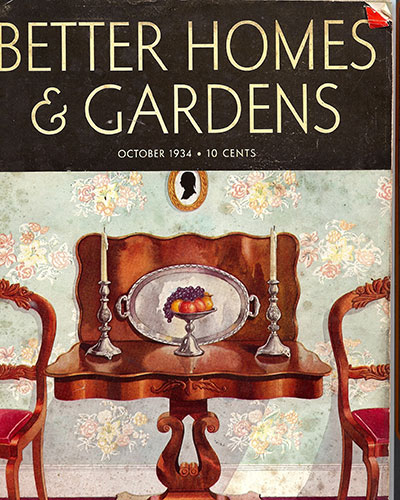
In Woody Allen’s 1973 movie “Sleeper” – where health food storeowner Miles Monroewakes up after a two-century cryogenic sleep -doctors ponder their defrosting patient.
Dr. Melik: This morning for breakfast he requested something called “wheat germ, organic honey and tiger’s milk.”
Dr. Aragon: Oh, yes. Those are the charmed substances that some years ago were thought to contain life-preserving properties.
Dr. Melik: You mean there was no deep fat? No steak or cream pies or hot fudge?
Dr. Aragon: Those were thought to be unhealthy, precisely the opposite of what we now know to be true.
A recent encounter with the October 1934 edition of Better Homes & Gardens reminded me of that, because if there’s anything you can count on, it’s that today’smandates will be tomorrow’s anathema, and visa versa.
BH&G debuted in1922 – modern consumerism’s infancy -heralding”the dawn of a new era of home betterment.” The same year F. Scott and Zelda Fitzgerald moved into a brand new house in Great Neck, Long Island; the 1920s “Gold Coast,” where trendsetter like the Fitzgeralds defined the “new era.” They didn’t record much home-betterment, beyond cocktail shaker inventory, the “better” bootleggers’ addresses, bathtub gin recipes, and a lampshade sported by poet and novelist John Dos Passos atthe non-stop Fitzgerald bacchanal.
The 1930s inaugurated another new era for BH&G (as well as the Fitzgeralds; who went their separate ways – Zelda to schizophrenia, Scott to Hollywood). Bathtubswereno longer commandeered for liquor production,and the National Housing Act opened a new, government-subsidized market for home betterment – what copywriters called “modernizing money on easy terms.”
And the must-haves for 1934’sconscientious homeowner?Pretty much everything we’ve been trying to expunge since the 1970s.
Fiberglass fabric was one, andBH&G predicted”Glass curtains will prove popular this year.” Fiberglass’ charm is in that itdoesn’t, burn, shrink, wrinkle, or foster mold. The downside of glass fabric is that it’s, well, glass.
By the mid-1970s the condition caused by contact between skin and fiberglass had a name:fiberglass dermatitis. Not to mentionglass fibers left behind after washing, to be picked up by the next batch of laundry.
Even more toxic materials await in up-coming pages.
A full-color ad features Dutch Boy White-Lead, “Good Paint’s Other Name;” telling the story of askinflint homeowner who used “cheap” exterior paint and must scrape, prime, and repaint 18 months later. By contrast, the smart homeownernext door spent $20 more (1934 dollars) on Dutch Boy, whose white lead goodness is still going strong three years later. “It resists the weather … wears down stubbornly … leaving a smooth, unbroken surface that needs no burning and scraping at repaint time.”
During World War II, Dutch Boy White-Lead’s staying power became the patriotic choice as well- conserving manpower and material for the war effort.
But the 1930s’ greatestconstruction infatuation was asbestos. It seemed nothingcouldn’t be improved by adding asbestos. Anaconda Copper Co.’s copper roofing bonded to Asbestos Felt. Ruberoid Company’s “Eternit” asbestos-cement siding and roof shingles.
But the brandsynonymous with”asbestos” was, and still is, Johns-Manville – albeit now as a defendant in Mesthelioma lawsuits. Homeownerscould write J-M for “101 Practical Suggestions on Home Improvements,” predictably supplying 101 asbestos-ifiedwaysto reduce neighbors to green-eyed envy.
“$19.50 down gives you a new roof you’ll be proud of – and will never wear out! J-M Asbestos Shingles go on right over your old roof.” “Eliminate repair bills forever by putting on J-M Asbestos Siding Shingles.” “Modernize the living room with J-M Insulating Board. “Make your bathroom lovely, cheerful, modern with J-M ‘tile-like’ wainscoting.” “Put a beautiful extra room in basement or attic, finished with J-M insulting Board in its natural buff.” “Save up to 25% on fuel bills with J-M Rock Wool Home Insulation spun from molten rock.”
What did worry people as they laidon the white-lead paint and asbestos? Inadequate lighting.
“Few dangers faced by young children entail more serious consequences to their health and future than light to which they are subjected in the home,” wroteIlluminating Engineering Society’s D.W. Atwater. “In children the strain on the eyes imposed by improper home lighting often appears in severe attacks of indigestion, irritability, nervousness, and many other illnesses which interfere with normal growth and healthy development.”
Atwater’s 2,000 word directive in 6-point type promised to make “your own life happier thru his [your child’s] better health, better grades, and keener interest in ‘doing things at home.'” Atwater hadn’t encountered World of Warcraft, or he may have been less keen on “doing things at home.”
So whenyou’re told to insulate your house with “mineral wood fiber” andcover it with “post-industrial recycled thermoplastic polyolefin and ethylene propylene diene M-class polymer” roofing, just remember the Johns-Manville Company and take it with a grain of salt. And don’t worry too much about the salt.





